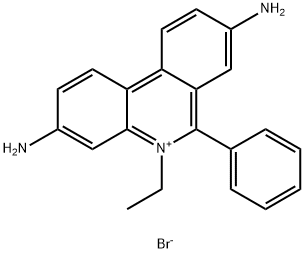溴化乙啶
| 中文名称 | 溴化乙啶 |
|---|---|
| 中文同义词 | 溴化乙腚;溴化-3,8-二氨基-5-乙基-6-苯基菲啶翁;溴化乙啶;溴化乙啶/溴乙菲啶;溴化乙啶(EB);溴化乙锭, 98%(DRY WT.);胡米溴铵;EB,溴化乙啶 |
| 英文名称 | Ethidium bromide |
| 英文同义词 | 3,8-diaMino-5-ethyl-6-phenylphenanthridin-5-iuM broMide;EthidiuM broMide dropper bottle,5Ml;2,7-Diamino-10-ethyl-9-phenylphenanthridinium bromide, 1% aqueous solution;Ethidinium bromide, 3,8-Diamino-5-ethyl-6-phenylphenanthridinium bromide;EthidiuM BroMide, OMniPur(R);EthidiuM broMide, pure, 95% 1GR;EthidiuM broMide, pure, 95% 5GR;Dromilac |
| CAS号 | 1239-45-8 |
| 分子式 | C21H20BrN3 |
| 分子量 | 394.32 |
| EINECS号 | 214-984-6 |
| 相关类别 | 细胞生物;用于生产的化学试剂;基因组学和分子诊断;微生物;小分子抑制剂;生物化学;无机化合物和盐;其他生化试剂;荧光探针,标记,颗粒和染色;生化试剂;色素类;Amines;Aromatics;Intermediates & Fine Chemicals;Pharmaceuticals;marker;Purines;Phenanthridine;分子生物学 |
| Mol文件 | 1239-45-8.mol |
| 结构式 |  |
溴化乙啶 性质
| 熔点 | 260-262 °C (dec.)(lit.) |
|---|---|
| 密度 | 1.3739 (rough estimate) |
| 堆积密度 | 340kg/m3 |
| 折射率 | 1.6700 (estimate) |
| 闪点 | >100°C |
| 储存条件 | 2-8°C |
| 溶解度 | H2O:10 mg/mL,不透明,深红色 |
| 形态 | 粉末 |
| 颜色 | 红色至深紫色 |
| 气味 (Odor) | 无味固体 |
| PH值 | 4.4 (20°C, 10g/L in H2O) |
| 水溶解性 | 40 g/L (25 ºC) |
| 最大波长(λmax) | 518 nm, 210 nm, 285 nm, 316 nm, 343 nm, 480 nm, 525 nm |
| Merck | 14,4731 |
| BRN | 3642536 |
| 稳定性 | 稳定的。与强氧化剂不相容。 |
| 生物领域应用 | Nucleic acid hybridization; detecting nucleic acids,cells,cancer cells,human cytomegalovirus,hydrogenase A (hydA) of Clostridia,influenza A virus,oligonucleotides,viable Plesiomonas shigelloides; apoptosis assay; nucleic acid quantification |
| 主要应用 | Electroluminescent displays;photoresists |
| CAS 数据库 | 1239-45-8(CAS DataBase Reference) |
| EPA化学物质信息 | Phenanthridinium, 3,8-diamino-5-ethyl-6-phenyl-, bromide (1239-45-8) |
荧光分析法可分为直接测定法和间接测定法二种。直接测定法是利用物质自身发射的荧光,即所谓“自荧光”或“内源荧光”来进行测定。但在自然界中只有少部分物质在光激发后可以发射荧光,而有相当一部分物质发荧光很弱或不发射荧光,如蛋白和核酸就是发荧光很弱的物质。为了充分利用荧光分析法灵敏度高这一特点就需使其转化成荧光物质再进行测定。此时可用某些试剂(如荧光染料) 使其与荧光较弱或不显荧光的物质共价或非共价结合,以形成发荧光的结合物再进行测定,这就是所谓的“荧光探针”技术或“荧光标记”技术。使试剂(荧光剂) 吸附在大分子上或共价结合到大分子上。所用的染料溴化乙啶被叫做“荧光探剂”。探剂荧光特性的变化,实际上是由于大分子构象的变化所引起的探剂环境变化的信号,所以利用这种信号还可以得到大分子构象变化的信息。Ethidium Bromide (Homidium bromide, EtBr, EB) 是一种嵌入剂,与DNA碱基对类似。EtBr在分子生物学实验技术(如琼脂糖凝胶电泳)中经常被用于荧光标记(核酸染色)。
Guidelines (Following is our recommended protocol. This protocol only provides a guideline, and should be modified according to your specific needs).
The preparation of agarose gel:
1. Agarose gels are commonly used in concentrations of 0.5% to 2.5% depending on the size of bands needed to be separated.
2. Mix the agarose powder with 1X TAE/TBE.
3. Microwave for 1-3 min until the agarose is completely dissolved (
Caution
: not overboil).
4. Make the solution cool down before solidification.
5. Add ethidium bromide (EtBr) to a final concentration of approximately 0.2-0.5 μg/mL (Stocks are generally 10 mg/ml, and require 5 µL stock/100 mL gel).
6. Ethidium bromide binds to the DNA and you could visualize the DNA under ultraviolet (UV) light.
CAUTION: EtBr is a known mutagen. Please pay attention to strengthening protection.
Ethidium bromide (EtBr) is the most commonly used nucleic acid stain for PAGE or agarose gel electrophoresis. The fluorescence of EtBr increases 21-fold upon binding to double-stranded RNA and 25-fold on binding double-stranded DNA so that destaining the background is not necessary with a low stain concentration. Ethidium bromide has been used in a number of fluorimetric assays for nuc leic acids. It has been shown to bind to single-stranded DNA (although not as strongly) and triple-stranded DNA. Because of its ability to bind to DNA, EtBr is an inhibitor of DNA polymerase. Antiprot ozoal (Trypanosoma).
安全信息
| 危险品标志 | T,T+ |
|---|---|
| 危险类别码 | 23-68-36/37/38-26-21/22-22 |
| 安全说明 | 36/37-45-36/37/39-28A-26-22-28-63 |
| 危险品运输编号 | UN 2811 6.1/PG 1 |
| WGK Germany | 3 |
| RTECS号 | SF7950000 |
| F | 8-9 |
| 危险等级 | 6.1 |
| 包装类别 | I |
| 海关编码 | 29339990 |
| 毒害物质数据 | 1239-45-8(Hazardous Substances Data) |
| 毒性 | Intercalating dye widely used to stain DNA in gels and gradients. The DNA can be visualized readily by irradiation with ultraviolet light, as little as 0.5 μg of DNA being detectable by such methods. Ethidium bromide is also added to cesium chloride density gradients, since as an intercalating molecule it binds more readily to linear DNA than to closed collinear circles of DNA (such as plasmids). Binding of ethidium bromide reduces the density of DNA, thus covalent circles of DNA have higher densities at saturating concentrations of ethidium bromide, permitting the separation of plasmid DNA. Ethidium bromide is a putative carcinogen. |
| 提供商 | 语言 |
|---|---|
|
英文
|
|
|
英文
|
|
|
英文
|
|
|
中文
|
|
|
英文
|
